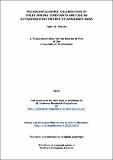Files in this item
Microcantilevers : calibration of their spring constants and use as ultrasensitive probes of adsorbed mass
Item metadata
| dc.contributor.advisor | Hahner, Georg | |
| dc.contributor.author | Parkin, John D. | |
| dc.coverage.spatial | 189 | en_US |
| dc.date.accessioned | 2013-06-05T08:25:30Z | |
| dc.date.available | 2013-06-05T08:25:30Z | |
| dc.date.issued | 2013-06-26 | |
| dc.identifier | uk.bl.ethos.574802 | |
| dc.identifier.uri | https://hdl.handle.net/10023/3608 | |
| dc.description.abstract | The dynamic properties of several rectangular and V-shaped microcantilevers were investigated. Particular attention was paid to the higher flexural eigenmodes of oscillation. The potential of the higher flexural modes was demonstrated through the use of cantilevers as standalone sensors for adsorbed mass. The mass adsorbed on the surface of a cantilever was in the form of a homogeneous water layer measured as a function of relative humidity. The minimum detectable water layer thicknesses were 13.7 Å, 3.2 Å, 1.1 Å, and 0.7 Å for the first four modes of a rectangular cantilever, clearly demonstrating enhanced accuracy for the higher eigenmodes of oscillation. These thicknesses correspond to minimum detectable masses of 33.5 pg, 7.8 pg, 2.7 pg and 1.7 pg for the first four modes. For quantitative applications the spring constants of each cantilever must be determined. Many methods exist but only a small number can calibrate the higher flexural eigenmodes. A method was developed to simultaneously calibrate all flexural modes of microcantilever sensors. The method was demonstrated for the first four eigenmodes of several rectangular and V-shaped cantilevers with nominal fundamental spring constants in the range of 0.03 to 1.75 N/m. The spring constants were determined with accuracies of 5-10 %. Spring constants of the fundamental mode were generally in agreement with those determined using the Sader method. The method is compatible with existing AFM systems. It relies on a flow of gas from a microchannel and as such poses no risk of damage to the cantilever beam, its tip, or any coating. A related method was developed for the torsional modes of oscillation. Preliminary results are shown for the fundamental mode of a rectangular cantilever. The method can be easily extended to the higher torsional modes, V-shaped cantilevers, and potentially, the flapping modes of the legs of V-shaped microcantilevers. | en_US |
| dc.language.iso | en | en_US |
| dc.publisher | University of St Andrews | |
| dc.relation | J.D. Parkin and G. Hahner. Mass determination and sensitivity based on resonance frequency changes of the higher flexural modes of microcantilever sensors. Review of Scientifc Instruments, 82:035108, 2011. | en_US |
| dc.relation | J.D. Parkin and G. Hahner. Determination of the spring constants of the higher flexural modes of microcantilever sensors. Nanotechnology, 24:065704, 2013. | en_US |
| dc.rights | Creative Commons Attribution-NonCommercial-NoDerivs 3.0 Unported | |
| dc.rights.uri | http://creativecommons.org/licenses/by-nc-nd/3.0/ | |
| dc.subject | AFM | en_US |
| dc.subject | Humidity | en_US |
| dc.subject | Fluid flow | en_US |
| dc.subject | Cantilever | en_US |
| dc.subject | Cantilever models | en_US |
| dc.subject | Calibration | en_US |
| dc.subject | Spring constant | en_US |
| dc.subject | Torsional | en_US |
| dc.subject | Flexural | en_US |
| dc.subject | Higher eigenmodes | en_US |
| dc.subject.lcc | TK7875.P2 | |
| dc.subject.lcsh | Microelectromechanical systems--Calibration | en_US |
| dc.title | Microcantilevers : calibration of their spring constants and use as ultrasensitive probes of adsorbed mass | en_US |
| dc.type | Thesis | en_US |
| dc.type.qualificationlevel | Doctoral | en_US |
| dc.type.qualificationname | PhD Doctor of Philosophy | en_US |
| dc.publisher.institution | The University of St Andrews | en_US |
This item appears in the following Collection(s)
Except where otherwise noted within the work, this item's licence for re-use is described as Creative Commons Attribution-NonCommercial-NoDerivs 3.0 Unported
Items in the St Andrews Research Repository are protected by copyright, with all rights reserved, unless otherwise indicated.


